
Mary, Queen of the World Cathedral or in full Mary, Queen of the World and St. James the Great Cathedral is a minor basilica in Montreal, Quebec, Canada, and the seat of the Roman Catholic Archdiocese of Montreal. It is the third largest church in Quebec after Saint Joseph's Oratory and the Basilica of Sainte-Anne-de-Beaupré east of Quebec City. The building is 101 m (333 ft) in length, 46 m (150 ft) in width, and a maximum height of 77 m (252 ft) at the cupola, the diameter of which is 23 m (75 ft).

Saint Patrick's Basilica is a Roman Catholic minor basilica on René-Lévesque Boulevard in Downtown Montreal, Quebec, Canada.
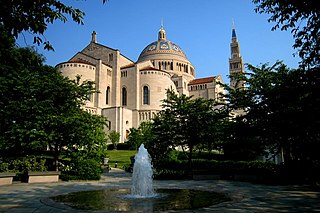
Maginnis & Walsh was an Boston-based architecture firm started by Charles Donagh Maginnis and Timothy Francis Walsh in 1905. It was known for its innovative design of churches in Boston in the first half of the 20th century.

Casavant Frères is a Canadian organ building company in Saint-Hyacinthe, Quebec, which has been building pipe organs since 1879. As of 2014, the company has produced more than 3,900 organs.

The Notre-Dame Cathedral Basilica is a Roman Catholic minor basilica in Ottawa, Ontario, Canada located on 385 Sussex Drive in the Lower Town neighbourhood. It was designated a National Historic Site of Canada in 1990.

The Basilica of the Sacred Heart in Notre Dame, Indiana, is a Catholic church on the campus of the University of Notre Dame, also serving as the mother church of the Congregation of Holy Cross (C.S.C.) in the United States. The neo-gothic church has 44 large stained glass windows and murals completed over a 17-year period by the Vatican painter Luigi Gregori. The basilica bell tower is 230 feet (70 m) high, making it the tallest university chapel in America. It is a contributing building in Notre Dame's historic district listed on the National Register of Historic Places. The basilica is a major tourist attraction in Northern Indiana, and is visited annually by more than 100,000 tourists.

Patrick Charles Keely was an Irish-American architect based in Brooklyn, New York, and Providence, Rhode Island. He was a prolific designer of nearly 600 churches and hundreds of other institutional buildings for the Roman Catholic Church or Roman Catholic patrons in the eastern United States and Canada, particularly in New York City, Boston and Chicago in the later half of the 19th century. He designed every 19th-century Catholic cathedral in New England. Several other church and institutional architects began their careers in his firm.

The Basilica of St. John is a Minor Basilica of the Catholic Church in the Drake neighborhood of Des Moines, Iowa, United States. It is also a parish church in the Diocese of Des Moines. The church building is listed on the National Register of Historic Places.

St. Anne Shrine is a historic local landmark located at the intersection of South Main and Middle streets in Fall River, Massachusetts. Until 2018, it was a parish in the Roman Catholic Diocese of Fall River. In addition to the church, the complex also includes the former Dominican Order monastery as well as the former Dominican Academy, constructed in 1894. The great upper church was formally dedicated on July 4, 1906 and closed November 25, 2018. The Lower Crypt Church shrine was re-opened July 4, 2019, but the upper part of the church remains closed for restoration and renovation.
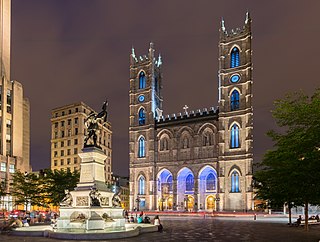
Notre-Dame Basilica is a minor basilica of the Catholic Church in the historic Old Montreal district of Montreal in Quebec, Canada. It is located at 110 Notre-Dame Street West, at the corner of Saint Sulpice Street. It is situated next to the Saint-Sulpice Seminary and faces the Place d'Armes square.

Notre Dame Catholic Church is a historic church in Southbridge, Massachusetts. It is one of two churches serving the Parish of Saint John Paul II; Saint Mary Church, located at the corner of Marcy and Hamilton Street, also serves as the location of the Parish Center and Rectory.

The Church of St. Michael and St. Anthony is a Roman Catholic church located in Mile End, Montreal. It was originally built as the Church of St. Michael and frequented by Irish Catholics. The growth of the Polish community in the area caused in 1964 for a Polish mission to be inaugurated in the church, whose name was expanded to "St. Michael and St. Anthony".
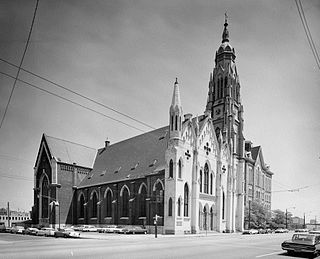
Holy Family Catholic Church is a Catholic church in Chicago, Illinois. It is the second-oldest such church in the city and one of the few structures that survived the Great Chicago Fire.

Joseph Venne (1858–1925) was a prominent Canadian architect whose practice was located in Montreal, Quebec. During a long and distinguished career he designed more than sixty buildings in the Montreal area and three large Catholic churches in Massachusetts.
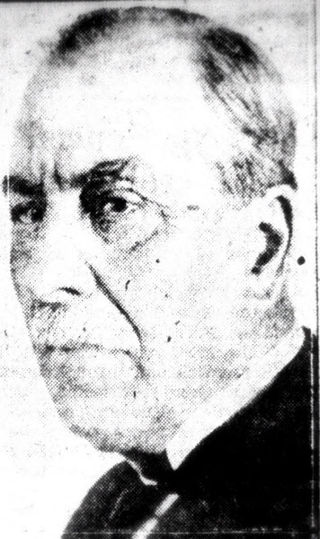
Louis G. Destremps (1851–1930) was a Canadian-born American architect who worked extensively with the Roman Catholic Church and other clients in Fall River, Massachusetts. He is the father of Louis E. Destremps, who also designed notable buildings in the New Bedford, Massachusetts area.

Notre Dame de Lourdes, known from 2012 to 2018 as St. Bernadette Parish, is a former Roman Catholic parish in Fall River, Massachusetts. A part of the Roman Catholic Diocese of Fall River, the parish was established in 1874 to serve the growing French-Canadian population located in the city's Flint Village section. Since its founding, the parish has occupied three different church buildings; a wooden structure (1874–1893), a spectacular granite church (1906–1982) and the current modern church (1986-2018). The parish complex over time has also consisted of other multiple buildings, including St. Joseph's Orphanage, The Jesus Marie Convent, a school, the church rectory, the Brothers' residence, and the former Msgr. Prevost High School. The parish also includes Notre Dame Cemetery, located in the city's south end.

Saint-Jean-Baptiste Church is a Roman Catholic church built in 1872 in the borough of Le Plateau Mont-Royal in Montreal, Quebec, Canada.
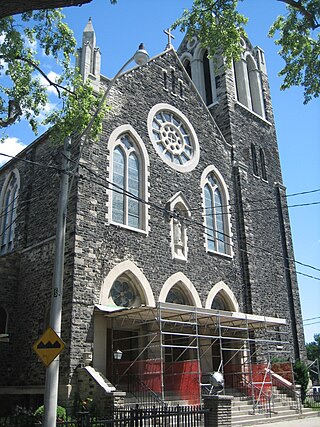
Saint Francis of Assisi is a Roman Catholic church founded in 1902 in Toronto, Ontario, Canada. It is located in the west end neighbourhood of Little Italy and Trinity-Bellwoods and within the Roman Catholic Archdiocese of Toronto.

The Church of St. Peter the Apostle is a Canadian Roman Catholic parish church, located between Boulevard René Lévesque and Rue Sainte-Catherine East, in the Village neighbourhood of Montreal, Quebec, Canada. It has been designated a Historic Place of Canada.

St. John's Episcopal Church, Georgetown, is a parish of the Episcopal Church located in the Georgetown neighborhood of Washington, D.C. Original plans for the church date to 1769, and the parish church was officially founded by Walter Dulany Addison in 1796. The church building was designed by architect William Thornton in the Federal style and was structurally completed in 1804, to be consecrated in 1809.























